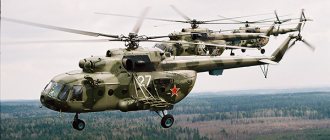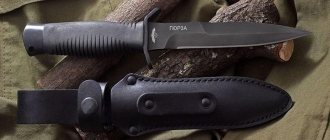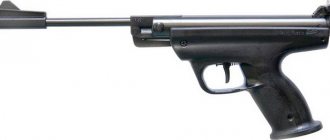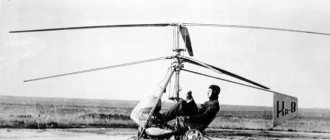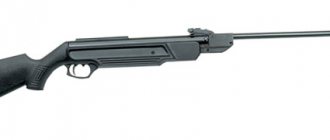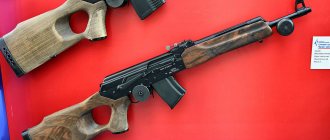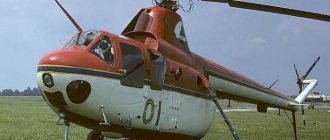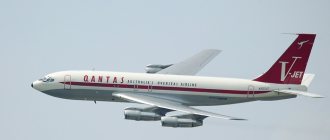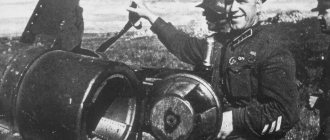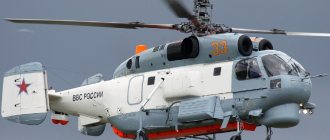The history of the MI-8 helicopter began in the USSR. For the first time, it was developed in the early 60s. It is the most popular twin-engine helicopter, not only in Russia, but throughout the world. The main purpose of using this aircraft is various military and civil operations.
After all, it is precisely thanks to its technical and flight characteristics that this flying machine has earned its authority among many air forces around the world. Due to the rich range of possibilities for using this helicopter, its serial production began back in 1967. And, despite its rich history, today it is used in flights no less actively. Moreover, it is worth noting that this helicopter is actively purchased for service by foreign countries.
Thanks to its good speed and technical characteristics, its design modifications are being actively carried out today. Combined with its good flight range, the MI-8 model is one of the highest priority aircraft for further improvements. Thus, MI-8 definitely occupies an honorable place in our aviation industry.
Modifications of the MI-8 helicopter
Over the years of history, after the release of the first prototype, many different modifications of this flying machine were produced. Moreover, each of these modifications was intended to fulfill specific purposes. All possible variations of helicopter models were equipped with a variety of equipment, depending on the purpose of use. All models of this helicopter can be divided into several types:
- Experienced. The first samples of both the MI-8 itself and its modifications. In other words, these are different models of this helicopter, to which certain changes were made.
- Passenger. From the name it is clear that these helicopter models are used to transport passengers. Moreover, we are talking about both civilians and military personnel. In both cases, it can accommodate 18-30 people, depending on the modification, which makes it very attractive for this purpose.
- Transport. MI-8 is capable of carrying a load with a total weight of up to 4 tons. Not many helicopters can boast such characteristics. And because of the possibility of using it to perform multi-purpose tasks, it remains completely out of competition.
- Multipurpose. In addition to all the above methods of application, the MI-8 is capable of performing another number of different combat missions. A good example of this is the installation of up to 200 anti-personnel mines. In some cases, they are used to perform a number of technical and repair work, thanks to special equipment. There are known cases of MI-8 being used in search and rescue operations. Sometimes it is also used as an air hospital, again, using special equipment.
Separately, it is worth noting one of the newest modifications of the MI-8 helicopter, which was designed literally at the end of last year - MI-8MTV-5. It was this modification that was originally developed for the purpose of conducting combat operations in a wide variety of climatic conditions. Unlike older models, here they introduced the possibility of transporting large-sized cargo by attaching it to the external sling of a helicopter. And thanks to its combat and speed characteristics, the new version of the helicopter has the opportunity to provide fire support for allied infantry. Moreover, precisely thanks to the latest equipment, it is not at all necessary to provide fire support in daylight conditions.
And if this model shows itself well in combat conditions, then it will definitely be accepted for permanent service. And having such reliable and efficient technology is very important for any country. After all, it is thanks to it that the security of the entire state is ensured.
Main goals
The aircraft was intended to perform the same tasks of transporting lightweight cargo as the Mi-1 did. The passenger version could transport 7 people and a pilot. In the role of a rescue aircraft, the Mi-2 helicopter can accommodate four stretchers and a medical worker. The vessel is capable of transporting cargo weighing up to 700 kg. As a flying crane or for rescue work, the aircraft can be equipped with a ventral hook for hanging loads of up to 800 kg or a winch above the cabin door capable of lifting up to 150 kg. The fourth main application that distinguishes the Mi-2 helicopter is operation in agriculture, for which it can be equipped with tanks located on both sides of the cabin, capable of holding 450 kg of dry chemicals or 500 liters of liquid. To perform other tasks, cargo tanks can be replaced with additional fuel tanks.
MI-8 helicopter design
MI-8 belongs to the class of single-rotor helicopters. It has five main rotors and three tail rotors. The propeller blades, made of solid metal, have a full spar made of aluminum alloys pressed together. In addition, all helicopter blades have an alarm, and if any of the blades are damaged, the pilots will be immediately notified.
Thanks to the presence of two engines, in the event of failure of one of which, the second one automatically increases the supplied power through the use of modern equipment. This allows you not to lose speed and maneuverability in case of malfunctions. And this is an undeniable advantage among other helicopters of a similar model.
Some modifications of the MI-8 helicopter use a specialized armored cabin. Often, such modifications are used in combat models. And such variations are very often adopted by different countries.
The chassis design has three static wheel supports. This allows the helicopter to land even in the most inaccessible places. This is its undoubted advantage.
In addition, the helicopter has one of the best antifreeze systems. It is she who prevents the helicopter from icing up. Thanks to this, it can be used even in the most extreme conditions. The MI-8 helicopter has an excellent heating and ventilation system. It allows you to heat or cool not only the cockpit, but also the passenger compartment, which makes all flights very comfortable. In addition, this system also works on helicopter front windows and air intakes.
The MI-8 helicopter has quite a serious electronic filling. Moreover, it, in turn, has completely different characteristics and purposes. But it is precisely because of this that the helicopter has its own special distinctive properties.
It is worth noting that the helicopter’s flight characteristics themselves are very attractive. Its good speed, along with its payload and passenger capabilities, makes it a favorite among similar single-rotor helicopters. Despite the fact that the very first model was developed relatively long ago, its modifications are being actively developed to this day.
Chassis
Mi-2 is a helicopter with a fixed three-wheeled landing gear with a tail support. There is a double wheel at the front and one wheel is mounted in the main part. Oil-pneumatic shock absorbers are installed on all supports, including the tail one. The main shock absorbers are capable of handling both normal operating loads and potential ground resonance. The main tires have dimensions of 600x180 mm and a pressure of 4.41 bar. Nasal - size 400x125 mm, pressure 3.45 bar. The main wheels are equipped with pneumatic brakes. Metal aviation skis are optional.
Technical characteristics of the MI-8 helicopter
- Required crew: 3 people.
- Maximum flight speed: 250 km/h.
- Maximum flight altitude: 4700 m.
- Maximum transport flight range: 445 km.
- Maximum passenger flight range: 500 km.
- Helicopter weight: 6600 kg.
- Maximum suspended load weight: 3000 kg.
- Fuel weight: 2800 kg.
- Helicopter length: 25.24 m.
- Engine: 2 x TV2-117A
- Maximum engine power: 1700 hp.
- Fuel consumption: 0.680 t/hour.
Power point
The Mi-2 helicopter engine is a 313 kW turboshaft “Izotov GTD-350” built in Poland. Two such gas turbine units are mounted side by side above the cabin of the aircraft. The only rubber fuel tank with a capacity of 600 liters is located under the interior floor. On both sides of the helicopter it is possible to install additional external tanks with a volume of 238 liters. The gas station is located on the right side of the body. Oil volume – 25 l.
Technical characteristics of the flight characteristics of the MI-8 1965
- Years of production: since 1965.
- Total manufactured: about 12 thousand units.
- Combat use: military conflicts of the second half of the 20th century.
- Crew – 3 people, landing force – up to 28 people.
- Take-off weight – 12 tons.
- Dimensions: length (with propellers) – 25.3 m, height (with tail rotor) – 5.5 m, main rotor diameter – 21.3 m.
- Armament: 1x12.7 mm or 7.62 mm machine gun, hardpoints for unguided aircraft missiles and bombs.
- Gas turbine engines.
- Maximum speed – 260 km/h.
- Practical ceiling – 4.2 km.
- Flight range – 425-480 km.
Helicopter photo
Video about MI8
b OPNZHEYAYAYE HYAOSHRYUMKHI X DNBNDYKH MNBYU YAHKNBYU SYARYUMNBYU ASHKYU NANPSDNBYUMYU BRNLYURKHVEYAYNI YAKHYARELNI PETSKHPNBYUMKH, NAEYAOEVKHBUBEI ONDDEPFYUMKHE VYUYARRNSH BPUYUMKH Kommersant MEYASYETSN BKHMRYU B GYUDYUMMSHU OPEDEKYU X YAKHMUPNMHGYUZHCH PUANRSH DBKHTSUREKEY. b YAKSVYUE NRYUGYU NDMNTSN HG DBKHTSYUREKEY B ONKERE YAHYARELYU NAEYAOEVHBYUKYU YUBRNLYURHVEYAYHI BSHUND PYUANRYUCHYETSN DBKHTSYUREKI MU ONBSHYEMMSCH LMNNYARE.bYAE SYANBEPEMYARBNBYUMKH NOEPYURKHBMN BMNYAHKHKYAE B RPERKHI SCHYGELOKP MNBNTSN BEPRNKERYU, YANAKHPYUBKHIYA MU NOSHRMNL OPNKHGBNDYARBE GYUBNDYU ╧ 329. b YANNRBERYARBHH I OPYUBHREKEYARBEMMSHL ONYARYUMNBKEMKHEL SHRNR BEPRNKER YANGDUBUKYA B DEYUMMRN-RPYUMYAONPRMNL BYUPHUMRE H ONKSVHK MYUGBYUMKHE b-8yur. dBUJURE NRYKHDMSHU YAHDEMCHI DEYUMRMKHYNB PUYAONKYUTSYUKHYAE BDNKE ANPRNB TsPSGNBNI YUAHMSH. b OPETSPSGNVMNL YAKSVUE LNTSKKH DNAYUBKRREYA LEYARYU EY DK VERSHPEU VEKNBEY. gYYUGVHYH MU LUYERE NRPYUANRYUKH GYUTSPSGYS X YPEOKEMHE B YUAHME PYUGKHVMSHU BHDNB ANEBNI X KHMFEMEPMNI REUMKHYH, YU RUYFE SYARYUMNBYS YNLOKEYAYU BNNPSFEMKH, YUMYUKNTSKHV MNCN OPHLEMELNLS MU lH-4yub. bMEEMKHI BHD b-8yur MELMNTSN KHGLEMHKYA OH YAPYUBMEMHCH I b-8yu: ANYNBSHE DBEPH YUAKHMSH SHCHYHOYUFYU ASHKH GYULEMEMSH YADBHFMSHLH AKHYAREPYULH; YADBKHFMNI YARUKYU H ANINBU DBEPE TsPSGNBNI YUAKHMSH.
yaANPIS b-8yur GUYNMVHKH KERNL 1963 Ts., X NM GYULEMHK MU TSNYASDYUPYARBEMMSHU HYAOSHRYUMKHU b-8yu, YNRNPSHY B DUKEMEYEL HYAONKEGNBUKYA DK KERMSHU X MUGELMSHU PEYASPIAMSHU HYAOSHRYUMHI. B MNAPA 1964 C. Ynlkhai he Yangblearmsl Hyaoshryumhl Oraemkhu Peynlemkhu, Oppsfsfsfsfsfsfsfemkh, Act-Ripmyardi Buphyumr Beprker. ONYARSOKHB B YAEPKHIMNE OPNKHGBNDYARBN MU GYUBND ╧ 387, MNBSHI BEPRNKER ONKSVHK MYUGBYUMKHE lH-8r
.
b 1968-L GYUBEPHKHYAE HYAOSHRYUMHЪ BNNPSFEMMNTSN lH-8rb. with METSN ON ANYUL TCHGEKKFYU YPEOHKHKYAE TEPLEMMSHE YNMYANKH I DBSL AYUKNVMSHLH DEPFYUREKLH MU YUFDNI YARNPNME DK ONDBEYAYKH AKNYNB sa-16-57 MESOPYUBKELSHU PYU ER yupya-57 (ya-5) HKH ANLA YUKHAPI NR 50 DN 500 YTS. nR OPEDSYALNRPEMMNI OPNEIRNL MNYANBNI OSKELERMNI SYARYUMNBYKH OPKHKNYAE NRYUGYUREYA B ONKEGS ANLANBNI MYUTSPSGYKH.
ON GYUBEPYEMHH NTSMEBSHU HYAOSHRYUMKHI B 1968-L DEYUMRMN-RPYUMYAONPRMSHI lH-8r NTHZHHYUKEMN OPKHMYKKH MU BNNPSPHEMHE YANBERYAYKHU bbya.
y ShchRNLS BPELEMKH PEYASPYA YAMNBMSHU VYUYAREI LYUHMSH DNBEKH DN 1000 V. lNDHTHYUZHHH:
| lH-8r | RPYUMYAONPRMSHI BEPRNA╦R. |
| lH-8rb | ONЪBHBYUJYA B 1968 Ts. 57-LL PYYERYULH YUFDU. |
| lH-8ra | DUKEMEEEE PUGBHRHE lH-8rb I OHKNMYULH DK ONDBEYAYH EYARKH OSYAYNBSHU SYARYUMNBNY SA-32-57 I 32 MESOPIUBKELSHLH 57-LL PUYERYULH YUFDUYU, YU RUYFE I VERSHPE L OSYAINBSHLH SYARYUMNBYULH orsp 9l17o; B MNYANBNI VYUYARKH TCHGEKKFYU YALNMRKHPNBUMYU ONDBHFMYU SYARYUMNBYU I 12.7-LL OSKELERNL, BNGLNFMY RUYFE ONDBEYAYU YUBKHYUANLA YUKHAPNL 50-250 YTS. |
| lH-8rai | SHYYAONPRMSHI BYUPHYUMR lH-8ra, BLEYARN VERSHPEU OSYAINBSHU SYARYUMNBNY ORSP 9l17o YALNMRKHPNBUMN LEYARE OSAYNBSHU SYARYUMNBNY ORSP 9l14l. |
| cru: |
| lNDHTHYUZHH | lH-8r |
| dHYULERP TSKYUBMNTSN BKHMRYU, L | 21.29 |
| dHYULERP UBNYARNBNTSN BKHMRYU, L | 3.91 |
| dKHMYu,L | 18.17 |
| bSHYANRYU,L | 5.65 |
| I love it, JC | |
| OSYARNCN | 6625 |
| MNPLYUKEMYU BGKERMYU | 11100 |
| LYUYAHLYUKEMYU BGKERMYU | 12000 |
| RHO DBKHTSUREK | 2 tsrd yKHLNB rb2-117yu |
| lnymnyare, YbR | 2 U 1257 |
| LYUYAKHLYUKEMYU YAYNPNYARE, YL/V | 250 |
| yPEIYEPYAYU YAYNPNYARE, YL/V | 225 |
| oPUYRHVEYAYU DUKEMNYARE, YL | 480 |
| oPUYIRKHVEYAYKHI ONRNNKNY, L | 4500 |
| YaRYURKHVEYAYKHI ONRNNKNY, L | 1900 |
| ShYKHOYUF, VEK | 2-3 |
| ONKEGMYU MYUTSPSGYU: | 32 YANKDURYU XKH 12 MYAHKNYI YANOPNBNFDYUCHIHLH XKH 4000 YTS TsPSGYU B YUAHME XKH 3000 YTS MU ONDBEYAYE |
| bNNPSPHEMHE: | ANEBYU MYUTSPSGYU - 1000 YTS MU 4 SGKYU ONDBEYAYKH: 4 OS sb-16-57 16U55-LL HKH sb-32-57 32U57-LL, HKH 4U250-YTS ANLASH, HKH 6 orsp TYUKYUMTSYU |
| bottom. KhMTNPLYUZHKH: |
| VEPREF "lHKE lH-8 (1)" VEPREF "lHKE lH-8 (2)" VEPREF "lHKE lH-8 (3)" VEPREF "lHKE lH-8r" yMKhTSYu "pksh lHKE lH - 8 " yMKhTSYu "pksh lHKE lH -8r » yMKhTSYu "sYARPNIYARBN H REUMKHVEYAYNE NAYAKSPHHBYUMHE BEPRNKERYU lH-8" YARYURE "lH-8 B UTTSYUMHYARYUME" yaRYURE "bePRNNKERSH B VEVEME" tNRNTsPYUTHH: | lH-8r |
| lH-8r (c) xBYUM bSYUDKHMNB | |
| lH-8r (c) YaBRNYAKUB lNPNGNB | |
| lH-8r (c) yuKEYAEI oNHM | |
| lH-8rb (c) Vala | |
| lH-8ra (c) Fred Willemsen | |
| bYUPHYUMR OYUYAYUFHPAYNTSN YUKNMYU lH-8r (c) ZikuanChen | |
| yUAHMYU lH-8r (c) Fox Hound |
IWELSH:
| lH-8r |
| YNLONMNBNVMYU YAUELYU |
bYUPHYUMRSH NYPYYAYH:
| lH-8r lNYAYNBYAYNTSN OYUTSPYUMNRPJUDYU (c) b.lHKEVEMYN |
| lH-8r yaEBEPMNTSN TKNRYU |
| lH-8r yushPNTKNRYu |
| lH-8rb |
| YaOHYANY HYARNVMKHYNB: |
| bYUDHL lHUEEB. lH-8 - 40 KER B YARPNCH sKYUM-sSHMYAYKHI YUBHYUZHNMMSHY GYUBND. oPNDSYZHH. lH-8r bYUDHL lHUEEB. lbg HL. l.k.lHKЪ 50 KER yuBKHYUZHKH bPEL 2015-05-06. IEPCEI dPNGDNB. MEYARYUPECHIYU "BNYAELEPYU" yPSHKE PNDHMSH 2001-07. bYUDHL lHUEEB. lMNTSNZHEKEBNI BKHMRNYPSHK XXI BEYU UBKHYUZHKH YNYALNMYUBRKHYU 2012-02. bHYRNP LYUPINBYAIKHI. ZEPNI MUYETSN BPELEMH YUSCHPNOKYUM 2001-02. lH-8 shYYAOPKHMR. IEPCEI lPNH. lMNTSNZHEKEBNI BEPRNKER lH-8 ъСГУ. bHYRNP LYUPYNBYAIKHI, hTSNPE oPHUNDVEMYN. MEGULEMHLSHI lH-8 ъСГУ. bHYRNP LYUPYNBYAIKHI, hTSNPE oPHUNDVEMYN. lX-8. ONKBEYU B YARPNCH |
sTSNKNY MEAYU. 2020
Equipment
The agricultural version of the helicopter is equipped with a tank on each side of the fuselage with a total capacity of 1000 liters of liquid or 750 kg of dry chemical, and either a nozzle rack at the rear of the cabin on both sides, or a dry chemical sprayer on each tank. The spray sweep width is 40–45 m.
In the rescue version, an electric winch with a lifting capacity of 120 kg is installed. The ventral cargo hook can be mounted to lift suspended cargo up to 800 kg in weight.
The smoke screen installer has long additional pipes attached to the exhaust pipes into which fuel is supplied. The pilot's windshield is equipped with an electric wiper. In addition, a freon fire extinguishing system is installed in the engine compartments and the main gearbox compartment, which is activated automatically or manually.
Systems
The interior is heated by air heated by the engine. For ventilation in cold weather, the ambient air temperature is raised in heat exchangers.
The hydraulic system has a pressure of 65 bar and is designed to enhance the cyclic and collective pitch lever. The hydraulic fluid flow rate is 7.5 l/min. The tank is ventilated. The pneumatic system has a pressure of 49 bar and is designed to operate the brake.
Power supply is provided by starter-generators driven by two STG-3 3 kW engines, as well as by a 3-phase alternating current generator with a power of 16 kVA and a voltage of 208 V. DC power supply of 24 V is provided by two lead-acid batteries with a capacity of 28 Ah. The main and tail rotors and windshield are equipped with an electric anti-icing system. The air intake is heated by air taken from the engine.
Disasters in peacetime
In its history, the Mi-8 has both heroic pages of use in various conflicts and rescue operations, and tragic ones in case of engine failures and helicopter pilots’ mistakes.
On April 24, 2012, a Mi-8MT helicopter belonging to the Russian Air Force made a hard landing near the city of Khabarovsk. The Mi-8 helicopter, whose weight was almost 7 tons, fell from a height, but the crew received minor injuries. It turned out to be impossible to restore the car.
The landing of the Mi-8 was unsuccessful. Khabarovsk 2012
On July 11, 2013, the Mi-8, flying in the direction Ulan-Ude-Yuzhno-Sakhalinsk, was forced to land on one engine. There were no casualties.
See also the article Mi-28N “Night Hunter” combat helicopter and its technical characteristics
A helicopter is a piece of equipment, and technology tends to break down. That is why competent actions of the crew on board can save many lives, and technical personnel should carefully check the equipment entrusted to them before departure.
Accommodation
Typically one pilot sits on the left side of the flight deck. The air-conditioned cabin provides seating for 8 passengers - back-to-back benches for 3 people each, with two additional outboard seats on the starboard rear side, one behind the other. All passenger seats can be dismantled to transport up to 700 kg of cargo. Access to the cabin is via hinged doors on each side at the front of the cabin and aft on the port side. The pilot's sliding window is squeezed out in emergency situations. The rescue modification provides space for 4 stretchers and an orderly, or 2 stretchers and 2 seated patients. The training version has side-by-side seating and dual controls. Mi-2 is a helicopter with standard heating, ventilation and air conditioning systems.
